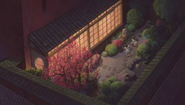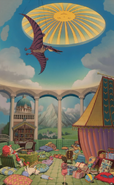The Bathhouse is a core location of the movie Spirited Away directed by Hayao Miyazaki of Studio Ghibli. It is owned by Yubaba, who mades a promise to hire anyone asking for a job there.
Exterior

The entrance.

The waterfall.
The Bathhouse, which stands on a half-dried swamp[1] is a very grandiose and opulent structure on the island Yūya in the Spirit Realm. Built in a traditional Japanese bathhouse style, its color scheme encompasses shades of red, green and semi-dark tones of brown. A waterfall is also present at its bridge crossing. Early in the series, it is established that the bathhouse has a set of old, unstable side stairs that lead directly into Kamajī's Boiler Room, bypassing the usual method of arriving by the internal elevators.
Aside from the bridge, waterfall, entrance and side stairs, the Bathhouse has multiple side entrances and back doors that can be used to dump water outside without being seen by the customers. Haku takes Chihiro through one of these backyard routes and instructs her to enter through the Boiler Room via the side stairs to meet Kamaji.
Interior
The Bathhouse is a structure with multiple floors. The floors above ground level are numbered in a special manner that incorporates use of the words "天", literally meaning "heaven" and "地", literally meaning "ground". The floors below ground are not given names in the film. It is shown in the film that the Bathhouse does have working, one-way elevators that travel to some of the floors if not all the floors by the pull of a lever.
The workers are also assigned to quarters in the bathhouse[2], though it is unknown which floor of The Bathhouse they sleep in. It is accentuated that their living space is extremely cramped and limited compared to Yubaba's office and Boh's room. It is unknown if workers higher on the job ladder have private quarters.
The order of the floors represent the hierarchy of Japanese society[3]
Floors
The back side of the Bathhouse.
Inside the abyss.
- 1st floor
- Boiler Room
- escape path
- abyss
- 2nd floor
- Front side
- dining room
- baths
- Back side
- kitchen
- storage room
- garden
- Yubaba's Farm
- Front side
- 3rd floor
- Front side
- dining room
- domicile
- Back side
- bedroom of Employees of the Bathhouse
- Front side
- 4th floor
- dining room of the guests
- 5th floor
- pit to the abyss
- bathroom
- Boh's room
- kitchen
- look-out
- Yubaba's bureau
2nd Floor
Kamis like to take a shower.
The ground floor (地 ji, lit. ground) is seemingly dedicated to kitchens and customer-use baths. Due to their popular and constant use, some of the baths are notoriously known to be extremely dirty. During Chihiro's stay as a worker, she is assigned (with Lin) to clean the biggest and dirtiest tub on the ground floor, which, according to Lin, was one that hadn't been cleaned in months.
3rd and 4th Floor
The 4th floor.
The third floor (二天 niten, lit. second heaven) is dedicated to traditional Japanese tatami-matted dining rooms for customers. It is first shown during Chihiro's elevator ride through the building complex with the Radish Spirit. A long hallway with rooms separated by rice paper wooden doors line the second floor. They also seem quite popular with customers, as seen when all rooms are occupied Chihiro arrives on the level.
5th Floor
The top floor to Yubaba's bureau.
→ See also Top Floor
The top floor (天 ten, lit. heaven) has two doors, with the right one having a talking door knocker. The left door is never opened, but the right door is home to Yubaba's office and Boh's room. It is an opulently-built, largely unoccupied space lined with expensive vases accentuated by intricate architecture. Yubaba's office lies on this floor, conjoined with Boh's bedroom. Multiple large wooden doors, which close off at least four other rooms, block the path to Yubaba's office, followed by many, twisting hallways. As shown by Haku, the top floor can also be accessed by a long, spiraling set of stone stairs.
Inspiration
Those places was used to design the Bathhouse[4]:
- Bathhouse in Dogo (Shikoku)
- Meguro Gajo-en
- Nikko Toshogu
- Open Air Architectural Museum in Koganei
- Nijo Castle
- Juifen and Omoneimoto Tea Museum in Taiwan[5]
Gallery
References
- ↑ The Art of Spirited Away, page 76
- ↑ most likely separated by male and female divisions
- ↑ Noriko T. Reider, Spirited Away: Film oft he Fantastic and Evolving Japanese Folk Symbols, Film Criticism 29, volume 3, 2005, page 14
- ↑ The Art of Spirited Away, page 96
- ↑ www.taipeinavi.com/food/276/article/, retrieved 15th February 2015
| Spirited Away | |
|---|---|
| Characters | |
| Main Cast | Chihiro | Haku |
| Chihiro's Family | Akio Ogino | Yuko Ogino |
| Bathhouse Denizens | Aniyaku | Aogaeru | Boh | Chichiyaku | Foreman | Kamaji | Kashira | Lin | Susuwatari | Yubaba | Yuna |
| Spirits | Kasuga-Sama | No-Face | Radish Spirit | River Spirit | Stink Spirit | Onama-Sama | Ōtori-Sama | Ushioni |
| Others | Shikigami | Zeniba | Hopping Lantern |
| Miscellaneous | |
| Locations | Spirit Realm | Red Gate | Clock Tower | Deserted Town | Bathhouse | Boiler Room | Yubaba's Office | Yubaba's Apartment | Sea Railway | Swamp Bottom | Zeniba's Cottage |
| Objects | Bath Tokens | Dōsojin Statue | Gold |
| Music | Soundtrack | Always with Me | One Summer's Day | Procession of the Gods | Reprise/Again |


